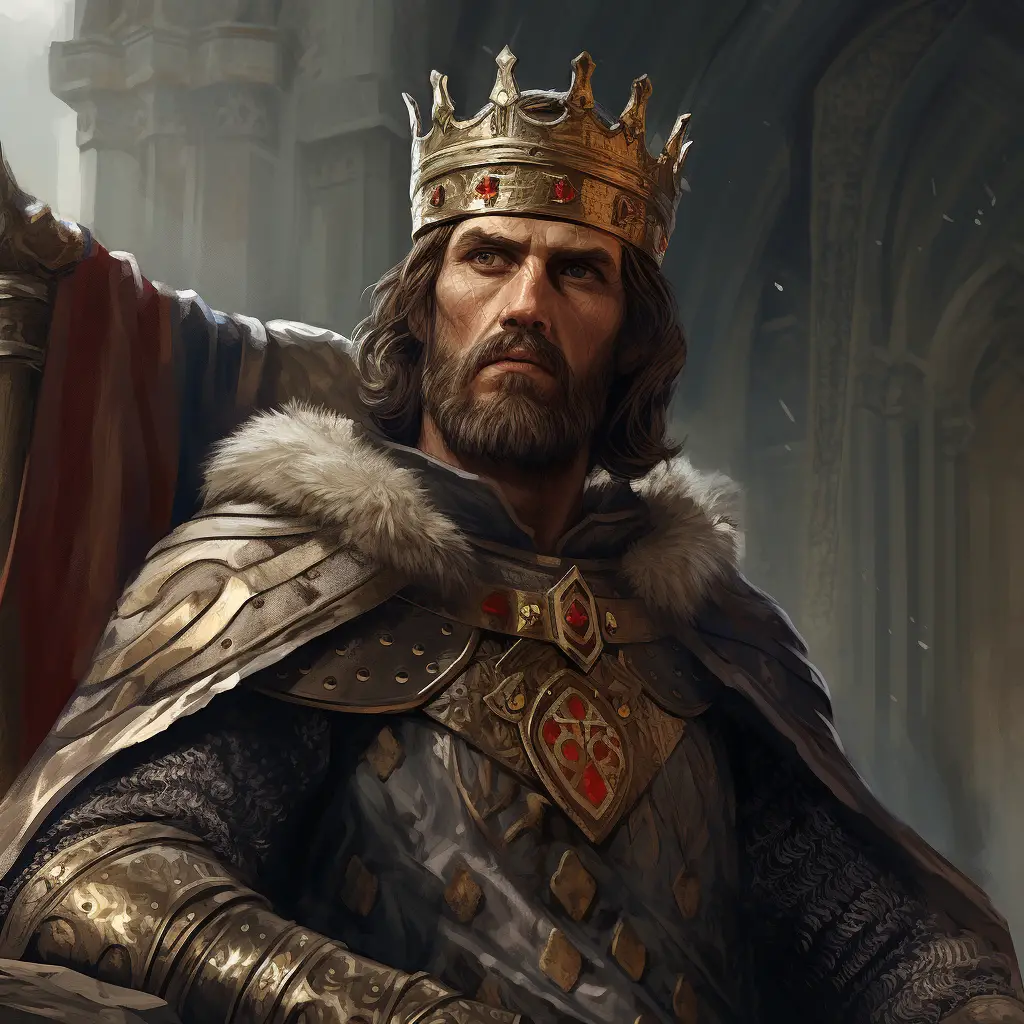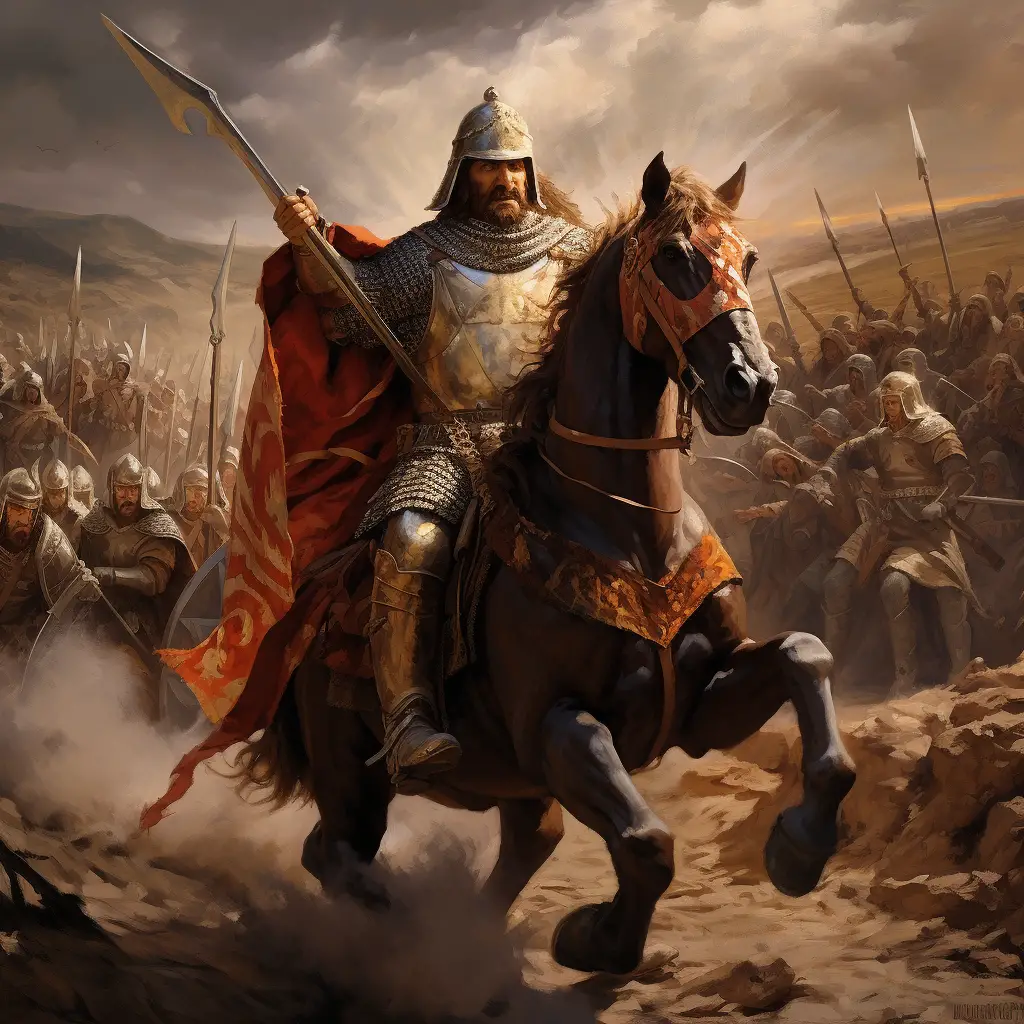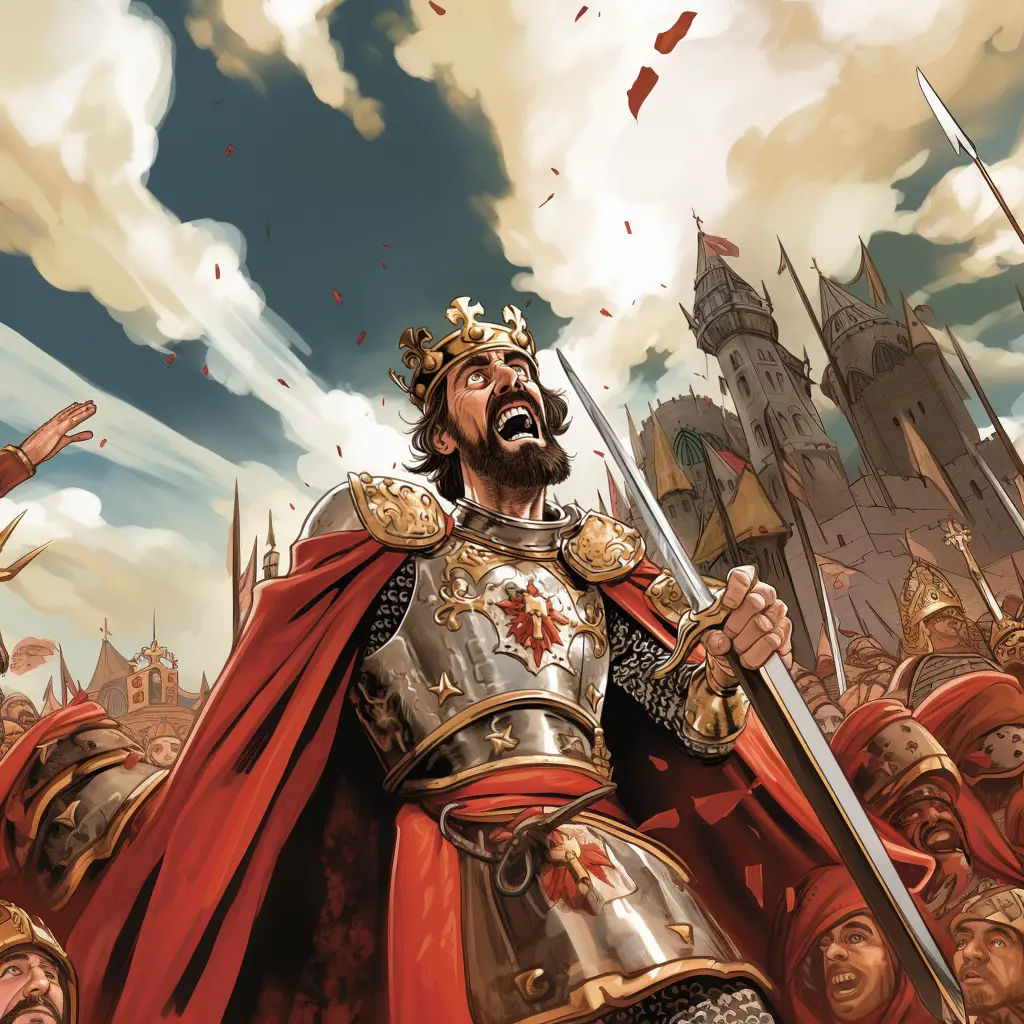Richard the Lionheart
Richard the Lionheart was a medieval king of England who is known for his military prowess and leadership during the Third Crusade. He was a skilled warrior and led his troops in battles against Saladin, the Muslim leader. Richard’s reputation as a brave and fearless warrior earned him the nickname “Lionheart.”
Despite his military successes, Richard faced challenges during his reign, including conflicts with his own nobles and his capture and imprisonment on his way back from the Crusade. He is remembered as a legendary figure in history for his bravery and chivalry.

Richard The Lionheart Facts For Kids
- Richard the Lionheart was the King of England.
- He reigned from 1189 to 1199.
- He was known for his courage in battle.
- Richard spent most of his reign abroad.
- He was a key figure in the Third Crusade.
- Richard didn’t speak English, his main language was French.
- His nickname comes from his brave heart in battle.
- He was captured and ransomed during his return from Crusade.
- Richard’s brother, John, succeeded him.
- He died from a wound inflicted by a crossbow.
Third Crusade
As the King of England, Richard the Lionheart played a pivotal role in the Third Crusade from 1189 to 1192. His bravery, military prowess, and effective leadership were fundamental in spearheading the Christian forces against the Muslim commander, Saladin.
Although the Crusade fell short of its ultimate goal to recapture Jerusalem, Richard’s strategic victories, such as the retaking of the crucial coastal city of Acre, ensured Christian dominion over certain regions of the Holy Land.
His relentless spirit on the battlefield won the admiration of allies and adversaries alike, and his significant contributions to the Third Crusade fortified his standing as one of the most esteemed warrior kings of the medieval era.
King John of England
Richard the Lionheart, famed for his heroic leadership during the Third Crusade, was the elder sibling of King John of England. His rule, largely marked by his absence due to his crusading activities, considerably influenced his younger brother’s ascension to the throne.
The Lionheart’s capture and subsequent ransom upon his return from the Crusades significantly drained England’s treasury, creating a difficult economic environment for King John’s reign.
Furthermore, Richard’s legendary reputation as a warrior king cast a daunting shadow, causing King John, who lacked his brother’s military skills, to often be unfavorably compared. Consequently, Richard the Lionheart’s reign had a profound impact on the rule and image of King John among the English populace.
Saladin
Renowned for his immense contribution to the Third Crusade, Richard the Lionheart, the courageous King of England, commanded his forces against the Muslim army led by Saladin.
Despite being formidable foes, the two legendary figures fostered a remarkable relationship of mutual respect and admiration. Saladin, recognizing Richard’s military expertise and chivalrous demeanor on the battlefield, held him in high regard.
Amid their disparate religious and cultural backgrounds, tales of their encounters frequently underscore a mutual honor code and respect for each other’s prowess. As such, the extraordinary bond between Richard the Lionheart and Saladin constitutes one of the most captivating chronicles in the annals of the Crusades.
Eleanor of Aquitaine
Eleanor of Aquitaine, recognized as one of the most influential women in medieval Europe, had a substantial effect in molding the life and rule of Richard the Lionheart. Her role as Richard’s mother encompassed his upbringing and education, where she fostered a passion for knowledge and chivalry in him.
His father, Henry II, was typically distant and engrossed in ruling the kingdom, leaving Eleanor as the guiding force in Richard’s intellectual and cultural growth. She promoted his fascination with troubadour culture and courtly love literature. Her influence didn’t stop at his personal development; she frequently acted as regent during his many absences caused by the Crusades, further extending her impact on his kingship.
Consequently, Eleanor of Aquitaine’s influence on Richard the Lionheart was remarkable, ultimately shaping him into the king and man he became.
Battle of Arsuf

Richard the Lionheart, the iconic English monarch, significantly influenced the course of the Third Crusade through his remarkable military strategies showcased in the Battle of Arsuf in 1191.
Renowned for his exceptional military skills, Richard led his troops against Saladin’s formidable army, employing tactical brilliance and inspirational leadership. His strategic victory in this critical battle disrupted the momentum of the Muslim forces and marked a crucial turning point in the Crusades.
Richard’s strategic expertise was vividly demonstrated in the Battle of Arsuf, as he astutely maneuvered the terrain and his troops’ disciplined formations to counter Saladin’s cavalry-centered offense. Despite the overwhelming numbers of the enemy, the Lionheart’s forces triumphed, significantly lifting the Crusaders’ morale and reinforcing Richard’s position as an outstanding military strategist.
Siege of Acre
Richard the Lionheart, a pivotal figure in the Third Crusade, notably emerged as a catalyst in the successful Siege of Acre, further solidifying his heroic image.
Arriving in the Holy Land in June 1191, Richard’s military acumen quickly became apparent, infusing the Crusaders with renewed vigor after two years of a seemingly endless siege. Under his strategic guidance, the city’s defenses crumbled within weeks.
His decision to build siege towers and catapults played a significant role in the Crusaders’ triumph, leading to the fall of Acre, a major victory for the Crusaders. However, his legacy remains tainted by controversy due to his subsequent decision to execute the city’s captives post-victory.
Medieval English Monarchy
Richard the Lionheart, a standout figure in the Medieval English Monarchy, ruled as England’s King from 1189 until his death in 1199. Renowned for his military skill and courage, Richard’s reign was distinguished by numerous successful military offensives, particularly his leadership during the Third Crusade against Saladin.
Even though he spent the majority of his reign abroad, Richard’s impact on the English monarchy was significant. His absence gave rise to heightened power and authority for the English barons, which ultimately reshaped the monarchy and set the stage for his brother, King John, to sign the Magna Carta.
Therefore, Richard the Lionheart’s reign marked a pivotal shift in the power dynamics between the monarchy and the nobility in medieval England.
Knights Templar
King Richard the Lionheart of England, famed for his leadership in the Third Crusade, was notably tied to the Knights Templar, a distinguished Catholic military order known for their excellent combat abilities, during the era of the Crusades.
The Templars were instrumental in safeguarding Christian pilgrims as they traveled to the Holy Land, a responsibility that Richard greatly valued. Recognizing their crucial role in preserving the Christian presence in Jerusalem, Richard often leaned on the Templars’ military expertise in his battle strategies.
His strategic partnership with the Knights Templar not only fortified his crusade endeavors but also established a historic connection that would eternally associate his reign with the legendary order.
Angevin Empire
Richard the Lionheart also recognized as Richard I of England, played a pivotal role in the expansion and consolidation of the Angevin Empire during the late 12th century. His exceptional military skills and strategic insight, particularly in the Third Crusade, earned him international fame.
Richard’s tireless endeavors in fortifying English territories in France further strengthened the Angevin Empire’s power. Despite often being away on Crusades or tending to his French territories, Richard’s reign was instrumental in preserving the Angevin Empire’s integrity and influence during a time of substantial political and military turmoil.
His primary focus was not England itself, but the wider Angevin holdings, contributing to a reign characterized by intermittent absences but of significant importance.
Troubadour Culture in Medieval Europe
Richard the Lionheart, a key figure of the 12th century, played a vital role in advancing the Troubadour culture – the movement of composer-poets – in Medieval Europe during his reign as King of England from 1189 to 1199, a period that marked the peak of the troubadour era.
Being a skilled poet and musician himself, Richard created a conducive environment for artistic expansion within his court, offering the troubadours patronage and recognition. His own compositions, often crafted in the langue d’oc – the preferred language of the troubadours, clearly illustrate the deep influence of this cultural revolution on his reign. By actively supporting and partaking in the Troubadour culture, Richard was instrumental in transforming it from a regional to a pan-European phenomenon.
Queen Eleanor
Richard the Lionheart, the iconic King of England, owed much of his formative influence and enduring legacy to his mother, Queen Eleanor of Aquitaine. This powerful, cultivated queen imparted to Richard a passion for chivalry, warfare, and poetry, shaping his complex persona as both a warrior and a cultured king. Their bond, formed in the courtly love tradition of Aquitaine, endured the test of political turmoil, rebellions, and even Richard’s long absences on Crusade. Queen Eleanor’s role in Richard’s life underscored her own political acumen and her influence on the medieval world.
Duke Leopold
Duke Leopold V of Austria was a pivotal figure in the tumultuous saga of Richard the Lionheart. During Richard’s return from the Third Crusade in 1192, Leopold captured him near Vienna, accusing him of arranging the murder of his cousin, Conrad of Montferrat. Despite Richard’s denial, Leopold delivered him to the Holy Roman Emperor, Henry VI. This event resulted in Richard’s infamous captivity and subsequent ransom, further inflaming the historical animosity between England and the territories ruled by Leopold, and underlining the perilous politics of the Crusader era.
French King – Philip II
Richard the Lionheart’s relationship with the French King, Philip II, was defined by rivalry and intermittent warfare, despite their initial alliance during the Third Crusade. Their tenuous bond was eroded by territorial disputes and personal animosities, leading to numerous conflicts on French soil. While Richard was renowned for his military prowess, Philip was known for his strategic acumen, and their contest significantly shaped Anglo-French relations. Richard’s time on French battlegrounds, often at the expense of his English kingdom, emphasized his deep-rooted Angevin identity and the complexity of his reign.
King Louis VII
King Louis VII of France bore a complicated relationship with Richard the Lionheart, fraught with both familial ties and political strife. As the first husband of Richard’s mother, Eleanor of Aquitaine, Louis was indirectly linked to Richard. Eleanor’s subsequent marriage to Henry II of England after her annulment from Louis set the stage for decades of conflict between the French and English crowns, with Richard inheriting these tensions. Despite the political rivalries, the interactions between Richard and Louis VII were vital in the complex web of medieval European politics.
Westminster Abbey
Richard the Lionheart’s connection to Westminster Abbey is largely posthumous, with his coronation being held at Winchester Cathedral rather than the traditional Westminster Abbey. Nevertheless, he holds significance to the Abbey due to the placement of his effigy there. In the 13th century, a life-sized wooden statue of Richard was erected in the Abbey, clad in painted gilded gesso with his lion emblem. This tribute, despite its subsequent loss, symbolizes the historical memory of Richard, preserving his image as a warrior king within the sacred halls of Westminster Abbey.
Early Life
Richard was born on September 8, 1157, in Oxford, England. His father was King Henry II of England and his mother was Eleanor of Aquitaine. He was the third son of King Henry and was the favorite of his mother, Eleanor. After his birth, Richard was raised in England and was taken to Normandy by his mother in 1165. He was an educated man who loved to write poetry. Richard took a keen interest in matters pertaining to the military and was amazingly talented.
He took over the command of his own army at the young age of only sixteen and fought rebels in Poitou. Henry II decided to distribute his kingdom among his three elder surviving sons. In 1170, Richard’s elder brother, Henry the Young King was crowned as the Titular King of England. At the time of his appointment, Richard was only thirteen years of age. Henry II had planned to award England, Normandy, and Anjou to Henry, Aquitaine, and Poitiers to Richard and Brittany to his third son, Geoffrey. Henry II, however; had plans to exercise authority over his sons.
The Great Revolt

In 1173, Henry the Young King, who was getting impatient to rule independently the territories given to him, revolted against his father and went to France to seek assistance from Louis VII, King of France. His brothers including Richard also followed him and were soon made vassals of Louis. They started to gather the support of barons and nobles both in England and France against Henry II.
However, Henry II put down the revolt, and Richard and his brothers were back in England, seeking Henry’s forgiveness. After this revolt, Richard ruled in Aquitaine and strengthened his control over his holdings. In 1183, Henry the Young King died and Richard became the eldest surviving son and heir to the English throne.
He, however, had a fractured relationship with his father who wanted him to surrender Duchy of Aquitaine to his younger brother John. Richard refused and joined hands with Philip II, son of Louis VII, and again revolted against Henry II. Richard and Philip’s army defeated Henry’s forces near Ballans, France in 1189 and Henry II appointed him as heir apparent. Only two days later Henry II died of a bleeding ulcer and Richard became King of England.
Reign
During his ten years long reign, Richard remained busy in military campaigns and the Third Crusade. Interestingly he spent only six months of his reign in England. The early days of his reign were marred by violence against Jews. Soon after, Richard and Philip II of France decided to go on the Crusade. Richard started preparations and collecting funds for the campaign.
He started off his military campaigns in 1190 by occupying Sicily and Conquering Cyprus in 1191. The same year he landed in Holy Land. Richard won a series of battles against the famed Muslim general, Saladin at Acre and Arsuf but subsequent battles ended in a stalemate and Richard could not take Jerusalem from Saladin. By now, Philip withdrew from the crusade and went back. Richard was worried about any mischief on his part and after agreeing to a three-year truce with Saladin, headed back.
He was captured near Vienna in 1192 by the Duke of Austria, Leopold V, while traveling back through Central Europe. In 1193, Richard was handed over to Henry VI, Holy Roman Emperor, who released him in 1194 after charging a hefty ransom. In his absence, his brother John revolted and usurped power with the help of Philip II. Richard then struggled against internal strife till he breathed his last.
Later Life and Death
Richard died on April 6, 1199. He was attacked by a crossbowman of his own army who wanted to take revenge on Richard for killing his family. The wound turned gangrenous and finally led to Richard’s death. Richard forgave his attacker as a last act of Mercy and freed him. He was succeeded by his brother John Lackland.



